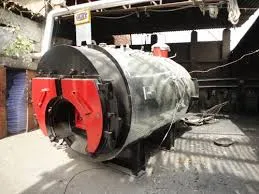
Nov . 05, 2024 19:00 Back to list
how steam boiler systems work
Understanding How Steam Boiler Systems Work
Steam boilers are integral components in many industries, providing essential heat and mechanical energy. Understanding how steam boiler systems work involves exploring their core principles, operating mechanisms, and the benefits they offer in various applications.
At its fundamental level, a steam boiler is a closed vessel in which water is heated to produce steam. This steam can be used for various purposes, including heating, power generation, and even driving machinery. The primary principle behind a steam boiler is the conversion of water into steam through the application of heat, utilizing various fuel sources such as natural gas, oil, coal, or even renewable biomass.
Components of a Steam Boiler System
A typical steam boiler system consists of several key components the boiler itself, a burner, a fuel supply system, a feedwater system, steam and condensate systems, and safety controls. The boiler's main function is to heat the water, while the burner ignites the fuel to create the necessary heat. The feedwater system ensures that the boiler receives a continuous supply of water, often pre-treated to prevent scale buildup and corrosion.
How Steam is Produced
The process begins when water is introduced into the boiler. The burner ignites and heats the combustion chamber, causing the temperature inside to rise. As the temperature climbs, the water absorbs heat and eventually reaches its boiling point. Once steam is generated, it expands and rises within the boiler. This steam can be directed through piping systems to various points of use or to a turbine for electricity generation.
how steam boiler systems work

Steam Utilization and Efficiency
Steam boilers are utilized across many sectors. In power plants, steam drives turbines connected to generators. In manufacturing, steam provides heat for processes like sterilization or drying. Hospitals use steam for heating and sterilizing equipment. The efficiency of a steam boiler system is crucial; systems are designed to maximize heat transfer while minimizing fuel consumption and emissions. High-efficiency boilers can reclaim heat from exhaust gases, significantly improving overall performance.
Safety Mechanisms
Given the high pressures and temperatures involved, safety is a paramount concern in steam boiler systems. Modern boilers are equipped with numerous safety features, including pressure relief valves, water level indicators, and automatic shut-off systems. Regular maintenance and adherence to regulations ensure these systems operate safely and effectively.
Conclusion
Steam boiler systems are vital players in ensuring smooth operations in various industries. By understanding their components, processes, and safety measures, operators can harness these systems to provide thermal energy efficiently and safely. As technology advances, the evolution of steam boiler systems continues, emphasizing energy efficiency and sustainability, making them even more crucial in a world that increasingly values environmental stewardship.
-
Efficient Biomass Fired Hot Water Boiler | AI Heating Solution
NewsAug.01,2025
-
High-Efficiency Gas Thermal Oil Boilers | HPT Models
NewsJul.31,2025
-
Oil Fired Hot Water Boilers Sale - High Efficiency & Affordable
NewsJul.31,2025
-
High-Efficiency Commercial Oil Fired Steam Boiler for Industry
NewsJul.30,2025
-
High-Efficiency Biomass Fired Thermal Oil Boiler Solutions
NewsJul.30,2025
-
High Efficiency Gas Fired Thermal Oil Boiler for Industrial Heating
NewsJul.29,2025
Related PRODUCTS






















